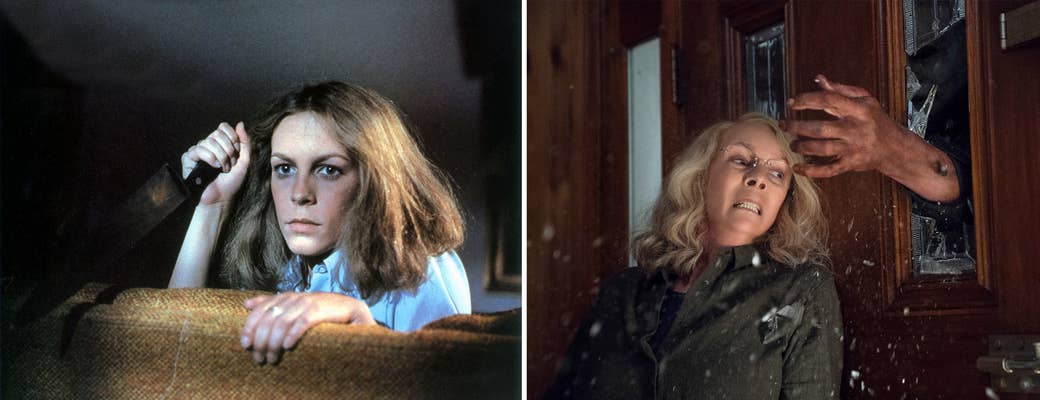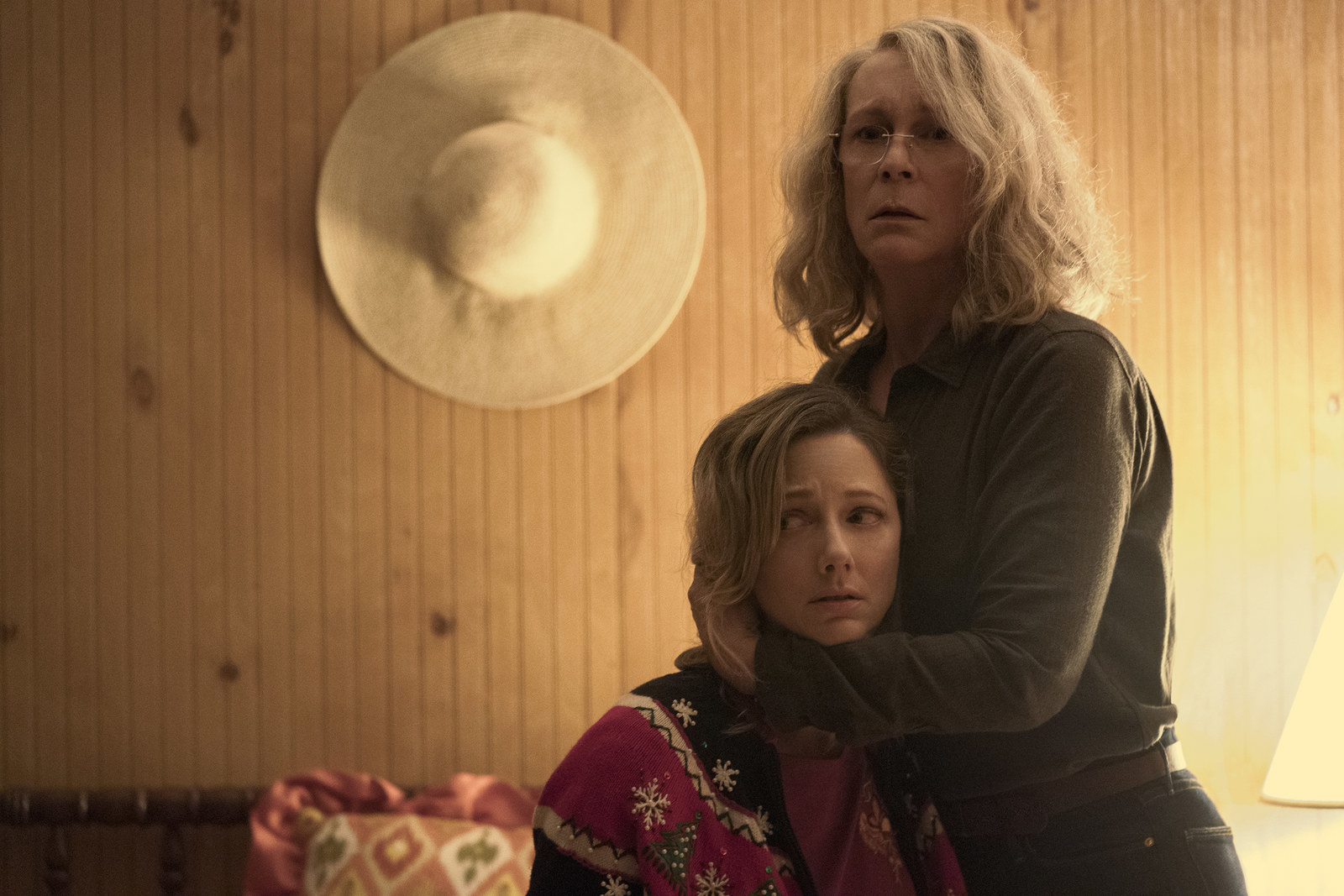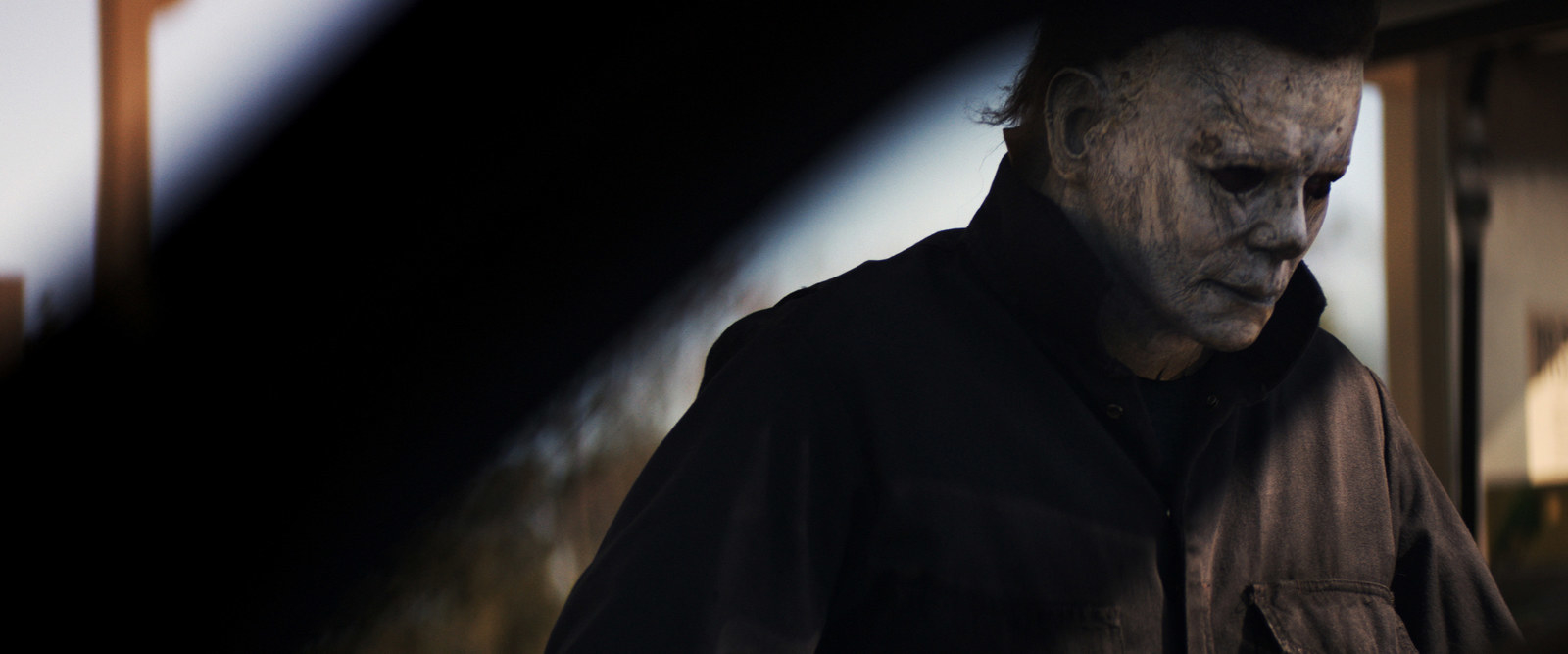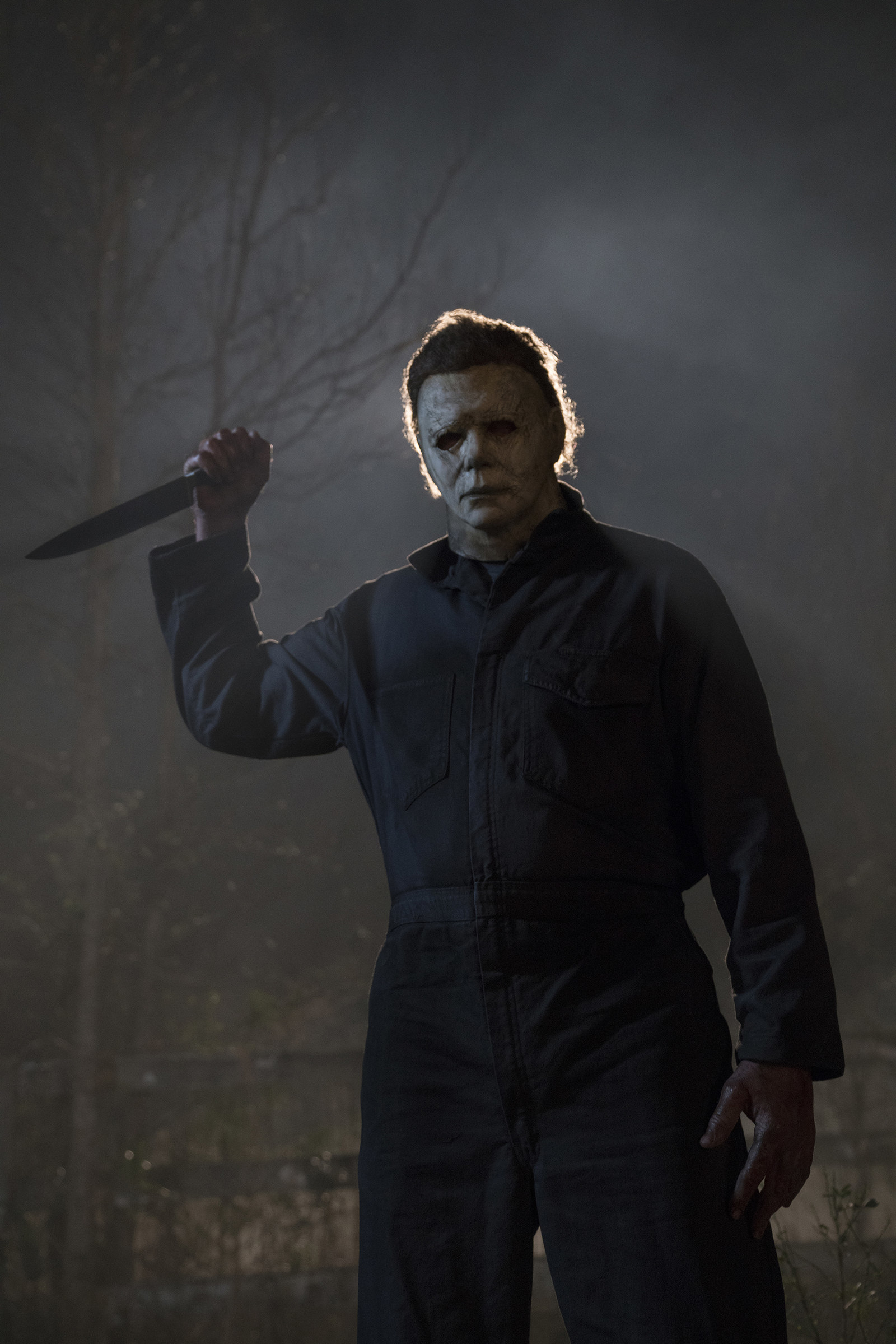It’s early February in Charleston, South Carolina, and it’s Halloween.
Not really, of course, but on this quiet, tree-lined street, you’d be forgiven for believing it’s already late October. There are pumpkins on porches and ghost decorations taped up on houses. Nearby, a woman is tearing up sheets to make more. And across the street, huddled in conversation, are two figures who have been linked with the holiday for the past 40 years: John Carpenter and Jamie Lee Curtis.
They’re here to film Halloween, a sequel to Carpenter’s 1978 slasher classic of the same name. Carpenter is an executive producer and a creative consultant on the new Halloween — as well as one of the film’s composers — and Curtis is stepping back into the role of Laurie Strode, which she hasn’t done since the character was killed off with a shrug in 2002’s Halloween: Resurrection. It’s been even longer since Laurie was front and center in 1998’s Halloween H20.
That was 20 years after the original Halloween; this is 40. And the 2018 Halloween — directed by David Gordon Green, with a script by Green, Jeff Fradley, and Danny McBride — has nothing to do with H20, or any of the sequels that came before it. There have been a staggering 10 films in the Halloween franchise, including Rob Zombie’s 2007 reboot and its sequel, but Green and his collaborators decided to scrap all the (admittedly murky) series continuity for their own take on Michael Myers. Early on, they announced that their Halloween would serve as a direct sequel to the 1978 original, ignoring everything that came after.
To pay homage to the Halloween they knew and loved, they had to start with a clean slate. While this Halloween is a little busier (and funnier) than its predecessor, they’re essentially mirror images of one another: The 1978 version had little to offer in terms of exposition, instead focusing on Laurie, her friends, and the masked killer picking them off one by one.
“To tie into all those [sequels] was like, this movie will become something where we spend half of it just trying to explain how we’re all back, and for fans, it feels like that’s what Carpenter’s not doing in the first one,” McBride told BuzzFeed News during a break from filming. “He’s not boring the audience with the crazy long backstory — he’s just putting you into it. So we were just kind of like, well, how can we not have to do that?”

It’s a risky move, particularly for a film that’s deliberately steeped in history: Nostalgia is part of the whole appeal of the new Halloween, and the movie has clear reverence for the films that came before it. But the cleaner, streamlined approach to continuity — essentially, chuck everything that wasn’t there from the very beginning — was a major part of what lured Curtis and Carpenter back. It also helped convince horror mega-producer Jason Blum that Green and his cowriters were the right team for the project.
“Trauma has an effect. Trauma has a result.”
“It’s a retelling, stylistically, characterologically, structurally, filmically,” Curtis told BuzzFeed News on the set. “In a way you could say it’s a remake, like a real remake of Halloween — but it’s not a remake. And you know it’s not a reboot.” She winced at the word. “I call it a retelling. It’s like the same story, but it’s retold 40 years later.”
And that’s just the way Curtis likes it. It was the straight line between the two films that brought her to the new Halloween, and back to the genre that once defined her. Because despite the fact that Curtis was once the quintessential “scream queen” — following Halloween with The Fog, Prom Night, and Terror Train — she’s largely soured on horror.
When asked about the trajectory of slasher films after the original Halloween, Curtis didn’t mince words. “You have to then make a big journalistic leap — assumption — that I give a shit,” she said. “I am not interested in the genre. I am not a genre fan.”

Curtis is no-nonsense and not afraid to get right to the point; the same could be said about present-day Laurie Strode. In the first Halloween, Curtis’s film debut, Laurie was “an innocent, virgin, intellectual, [a] repressed, emotionally nervous 17-year-old girl who then had a trauma inflicted upon her,” she said. In the 2018 Halloween, Laurie is cold, single-minded, and driven almost entirely by her certainty that Michael Myers, the man who murdered her friends and tried to kill her, will eventually come back to finish the job. Her relationship with her daughter, Karen (Judy Greer), is nonexistent, and she’s only a little closer to her granddaughter, Allyson (Andi Matichak). She spends most of her time with her gun collection in a remote, booby-trapped home, planning for Michael’s return.
“Trauma has an effect,” Curtis said. “Trauma has a result, and that was important to me.”
The 1978 Halloween had a major impact on horror films. Its surprising success sparked the slasher boom of the ’80s, inspiring movies like Friday the 13th and A Nightmare on Elm Street, which became massively successful franchises of their own. Halloween also helped establish the rules of the slasher genre — the hulking, silent masked killer; the horny, boozing teens who serve as cannon fodder; and the one innocent girl who survives. The “final girl” was first named by Carol Clover in her definitive book on the genre — Men, Women, and Chain Saws — and Laurie Strode is her purest embodiment.
Beyond a devotion to the original series, the opportunity to revisit the character was what thrilled the writers of the new Halloween. “[Laurie] created this sort of archetype in horror films of the final girl,” McBride said. “It was interesting to make a film that shows the effect of what happens to the final girl that many years later, and where she would be at, and how that horror would have affected her, and what it would have turned her into.”
“I was on the run in H20. I’m on the hunt in this movie.”
The question of what happens to the final girl isn’t entirely unexplored: In her book, Clover writes that most often they’re dispatched quickly in the sequel. Laurie does actually survive 1981’s Halloween II, but in the 1988 sequel Halloween 4, it’s mentioned that she died in a car accident. It wasn’t until Halloween H20 — which, and see if you notice a pattern here, ignored most of the sequels that came before it — that audiences got a chance to catch up with the character, two decades after that fateful Halloween night.
“H20 was a little bit my conception, even though I didn’t get a credit as a producer. I should have,” Curtis said. “At that point, it was very much about the trauma of somebody and what happens to them, so in that movie, Laurie was on the run, trying to hide from [Michael], and had succumbed to drugs and alcohol.”
In many ways, H20 was a typical entry into the late-’90s slasher resurgence brought on by Scream: Like its contemporaries, the seventh Halloween film was self-referential and cast with WB-era teen stars. But Curtis’s return as Laurie made H20 stand out. In this new timeline, the character had faked her own death and was now headmaster of a private boarding school under an assumed identity. She was still traumatized by Michael Myers, but a far cry from the more deeply damaged Laurie we meet in the 2018 Halloween. The new Laurie isn’t hiding — she’s never even left Haddonfield — in part because she’s sure that another confrontation with Michael is inevitable, wherever she goes.
“She is still, every day, reliving what happened 40 years ago to her, and when we find her and meet her, it’s very evident that her entire life is perseverated about Michael Myers,” Curtis added. “I was on the run in H20. I’m on the hunt in this movie.”

Halloween isn’t only offering a new take on Laurie — it’s also a fresh conception of Michael, or rather, a return to the Michael we met in 1978. Unlike other slasher villains, Michael has been mostly consistent: He’s never embraced sarcasm and whimsy like Freddy Krueger, or gone to space like Jason Voorhees. Over the years, however, Michael did get saddled with his fair share of cumbersome mythology. (The less said about Halloween: The Curse of Michael Myers, the better.)
In ignoring the sequels, Green, Fradley, and McBride let go of all that baggage — including the revelation in Halloween II that Michael is actually Laurie’s brother, a idea the new Halloween introduces quickly and then dismisses as a rumor. And that’s not a spoiler, Green said. “The more people that know that they’re not siblings, that we are scrapping that theme, I think the clearer our story becomes,” he explained. That familial link was another unnecessary complication, as far as the new writers were concerned, and getting rid of it was part of their effort at making something closer to the original Halloween than what’s come since.
“If he’s the essence of evil, the mystery of him is so much more exciting than to humanize him.”
“There’s something sort of mysterious about [Michael] in that first one, the idea that anybody could be his victim, that it’s not like he has some sort of clear objective,” said McBride, who was glad to ditch the idea that Michael is driven by trying to kill everyone in his bloodline. “It freed us up to be able to focus on these scares more, and not have to figure out how to juggle some sort of convoluted storyline of why this all made sense that I think ultimately the audience probably doesn’t even really give a shit about.”
Green and his cowriters believe that Michael is scarier when you know next to nothing about him: He’s a total blank, as underlined by his featureless white mask. In the new Halloween, Michael’s psychiatrist Dr. Sartain (Haluk Bilginer) is obsessed with trying to understand his patient, particularly with getting him to talk. Green admitted that he toyed with the idea of letting Michael speak — in an early draft of the screenplay, he uttered one word — but he said it ultimately became too complicated. “I was getting back in that world I was afraid of, of having to justify, theorize,” he explained. It was smarter, he realized, to leave the doctor — and the audience — wanting something that would never happen.
Filmmakers over the years have approached Michael in different ways, some even coming close to creating sympathy for him. Most notably, Zombie’s 2007 Halloween gave Michael a tragic backstory, including a troubled home life and bullies at school. In going the opposite route, Green acknowledged that he presented himself with a writing challenge — Michael is a “nothing character” who “doesn’t give you anything” to work with. But that’s what he sees as the appeal, and part of what has made Michael Myers such an enduring fixture in our collective nightmares.

“If he’s the essence of evil, the mystery of him is so much more exciting than to humanize him,” Green said. “If I see a kid with a messed-up life, I empathize with him. I want to feel bad for him. And in my mind, I want to be afraid of [Michael] first and foremost — and maybe only.”
But the new Halloween is shaped as much by what Green and his collaborators chose to include as what they excised. Their film is not only about Laurie, but about three generations of Strode women: Laurie’s daughter Karen and granddaughter Allyson are pivotal to the movie’s climax, a far cry from the original, where Laurie had to face off against Michael on her own. The performances — by Curtis and her costars, Greer and Matichak — are lived-in and allow for an emotional honesty that’s so often missing from the genre. And the film as a whole takes its time before putting them in peril, giving audiences a chance to get attached. On the Charleston set, the words the cast and crew kept returning to in describing Green’s approach to the story painted a clear picture: “realistic,” “gritty,” “grounded.”
“If we didn’t pick a path that was somewhat audacious, then we’re not gonna get the respect of anybody.”
The movie’s pacing recalls the first Halloween, which masterfully puts off the fateful showdown between Michael and Laurie until an hour into the film. Much of the film before that is spent on developing the characters and on the lingering dread of knowing the killer is about to strike. When he finally does, the audience is deeply invested in Laurie’s survival — and that intimate connection, the identification with the final girl, is why that concept became an essential ingredient to slashers of the era.
“That’s what John [Carpenter] did,” Curtis said. “[The audience] cared about her. They wanted to protect her.”
While many modern horror films have shifted away from character development to focus on kills — the reason people like Curtis have turned away from the genre — there are notable exceptions. Two of this year’s biggest horror hits, A Quiet Place and Hereditary, are deeply invested in family drama. But there’s no question the slasher got progressively dumber after its heyday and again after its late-’90s resurgence, and the genre as a whole has fallen out of favor. Even Carpenter, speaking to BuzzFeed News, said, “I don’t think they make many of them nowadays. The ‘slasher’ is sort of an ’80s term.”

The almost total absence of the slasher in 2018 is, in part, a sign of changing tastes: Audiences now seem to prefer supernatural stories, like the ghosts and demons of the Insidious and Conjuring franchises. But it’s also, in part, because more recent slashers haven’t taken the time to connect to their audiences through storytelling that goes beyond carnage. As Curtis put it, “You don’t care whether or not all those teenagers get chased by a bad guy and end up in some gruesome way, because you don’t care about them.”
Could this Halloween show us a way forward? It would be fitting, of course, if Green’s film ushered in the new age of the slasher, the way that its predecessor Halloween did.
Producer Malek Akkad understands the genre better than most. He has been working on Halloween films since the ’90s, and his father, Moustapha Akkad, was a producer on the original Halloween and the first eight sequels. He was cautious about predicting what effect the new Halloween might have, noting that few movies have the kind of massive cultural impact the original did. But, he said, “I do see it hopefully, yes, revitalizing that [slasher] space. And I would bet anything that you’re gonna see very soon another Friday the 13th and another Nightmare on Elm Street right on the heels of this.”
Of course, the future of the slasher largely depends on how Halloween is received. So far, the response seems to be overwhelmingly positive. The audience at the Toronto International Film Festival premiere in September was nothing short of rapturous, and critics — who tend to be more measured than midnight horror crowds — have mostly been impressed. The streamlined direct-sequel approach may have been a risk, but it seems to have resonated with fans, many of whom were likely ready for something both fresh and familiar.
Green admitted he was anxious before the premiere, but also confident that the finished film represented his vision. “I think if we weren’t, as writers, writing from a self-indulgent place of the movie we wanted to see, if we didn’t pick a path that was somewhat audacious, then we’re not gonna get the respect of anybody,” he said.
Regardless of how Halloween does, this won’t be the end of trying to keep the franchise — or Michael Myers — alive. Whatever the future holds for the Strode family, anyone with even a passing knowledge of the genre knows that you can’t keep a good slasher villain down. Green and McBride acknowledged that they’ve already discussed ideas for a sequel — “When you give your kid the keys to the Porsche, how do you not take it for an extra lap?” Green said — but they’re trying not to get too far ahead of themselves. They also know that eventually, another writer will take these characters on — maybe as a response to the 2018 iteration, maybe offering a different interpretation of the original, or maybe going for something else entirely.
“Good horror is something that you can’t even put into words why it scares you.”
Michael endures precisely because, like the new Halloween’s sequel-free conception, he offers a blank slate: He’s a “boogeyman” or a “shape,” as he’s also been called in the films, a monster that filmmakers and audiences can project their own fears onto. He feels both realistic (just a guy in a mask with a knife) and larger than life (he keeps coming back). In keeping things simple, the writers behind the new Halloween have tried to honor that with a Michael Myers who is somehow distant, immediate, and — above all else — terrifying.
“Good horror is something that you can’t even put into words why it scares you,” McBride said. “Through whatever lightning in a bottle Carpenter was able to create, he created something that I think just withstands the test of time. There’s just something horrifying about a shape coming to your home and ending your days.”
Greer noted the use of the term “boogeyman”: It feels appropriate to her. “He has no face,” she said. “He can go on and on forever.” ●

